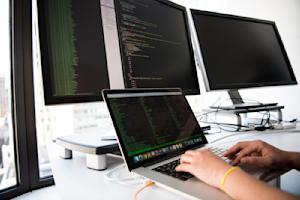In today’s fast-paced digital world, businesses and IT professionals require reliable and efficient tools to provide remote support. One of the most effective methods is remote attended access, which allows IT support teams to connect to a user’s device in real-time to troubleshoot issues, perform updates, or provide training.
This type of access is particularly useful when immediate assistance is needed, as it ensures that the user is present and able to interact with the support technician throughout the session.
Remote attended access simplifies the support process by enabling IT professionals to address problems as they arise, leading to quicker resolutions and higher customer satisfaction.
In this blog, we will explore what remote attended access is, how it differs from unattended access, and the best practices for using this powerful tool securely and effectively. Whether you're an IT support technician or a business looking to enhance your remote support capabilities, understanding remote attended access is crucial for ensuring seamless and secure operations.
What is Remote Attended Access?
Remote attended access is a type of remote support where an IT professional or technician connects to a user’s device while the user is actively present and participating in the session. This method allows the support technician to troubleshoot issues, guide the user through tasks, or perform necessary updates in real-time, with the user’s input and oversight.
The key characteristic of attended remote access is that the user initiates the session and remains engaged throughout the process. This interaction provides a collaborative environment where both the user and the technician can communicate directly, ensuring that the support provided aligns with the user’s needs and expectations.
Attended vs Unattended Remote Access
When it comes to remote support, understanding the difference between attended vs unattended remote access is crucial for determining the best approach for various situations. Both methods have their own set of advantages and are suited for different use cases, depending on the needs of the user and the IT support team.
Attended Remote Access
As discussed, attended remote access involves the active participation of the user during the remote session. The user initiates the connection and remains present while the technician provides support. This method is particularly effective in scenarios where real-time collaboration is needed, such as:
Unattended Remote Access
In contrast, unattended remote access allows IT professionals to connect to a device without the user being physically present. This type of access is typically pre-configured, enabling the technician to remotely access the device at any time, even when the user is not available. Unattended access is ideal for routine maintenance, monitoring, and support of managed machines.
The choice between attended and unattended remote access depends on the specific needs of the situation. For instance, attended access is better suited for interactive support and scenarios where user input is essential. On the other hand, unattended access is more appropriate for routine maintenance and emergency interventions, where immediate and autonomous access to the device is necessary.
Both methods play a vital role in modern IT support, and many businesses utilize a combination of attended and unattended access to ensure comprehensive and flexible remote support solutions.
Use Cases for Attended Remote Access
Remote attended access is a versatile tool that caters to a variety of situations where real-time support and collaboration are essential. Here are some common use cases where attended remote access proves invaluable:
1. Real-Time Troubleshooting
One of the most frequent applications of attended remote access is troubleshooting technical issues as they occur. When a user encounters a problem with their device, software, or network, they can initiate a remote session with IT support. The technician can then diagnose and resolve the issue on the spot, minimizing downtime and ensuring the user can quickly return to their tasks. This immediacy is especially critical in fast-paced work environments where every minute of disruption can lead to significant productivity losses.
2. Software Installation and Configuration
When new software needs to be installed or configured on a user’s device, attended remote access allows IT professionals to guide the user through the process or handle the installation directly while the user observes. This ensures that the software is set up correctly according to the user’s needs and that any questions or concerns can be addressed immediately. This use case is particularly relevant when dealing with complex software that requires specific configurations.
3. Training and Demonstrations
Attended remote access is also a powerful tool for training and demonstrations. IT teams can use remote sessions to walk users through new software features, demonstrate best practices, or provide hands-on training. This interactive approach ensures that users fully understand how to use the tools at their disposal and can ask questions or seek clarification in real-time. It’s an effective way to onboard new employees or introduce new technologies to an organization.
4. Remote Customer Support
For businesses that provide customer support for their products or services, attended remote access is essential. Support representatives can connect directly to a customer’s device to diagnose issues, walk them through troubleshooting steps, or demonstrate how to use a product. This level of personalized support can significantly enhance customer satisfaction and build trust in the company’s ability to provide effective solutions.
5. Security Incident Response
In the event of a security breach or potential threat, attended remote access allows IT teams to quickly respond by investigating the affected device while the user is present. The user can observe the actions taken and provide necessary information, such as recent activities or changes, that might have contributed to the issue. This collaboration helps in resolving the incident more efficiently and ensures that the user is informed about the steps being taken to secure their device.
6. Remote Collaboration and Assistance
Sometimes, users need help with tasks that are outside their expertise, such as configuring settings, setting up new hardware, or troubleshooting advanced issues. Attended remote access allows an IT technician to remotely take control of the user’s device and assist with these tasks while the user observes and learns. This not only resolves the immediate issue but also empowers the user with the knowledge to handle similar tasks in the future.
In all these scenarios, attended remote access provides a platform for effective, real-time collaboration between the user and the IT support team, ensuring that issues are resolved quickly and efficiently with minimal disruption.
Best Practices for Secure Remote Attended Access
While remote attended access offers significant benefits in terms of real-time support and collaboration, it is crucial to prioritize security during these sessions. Here are some best practices to ensure that remote attended access is conducted securely:
1. Use Trusted and Secure Remote Access Software
The foundation of secure remote attended access is choosing a reliable and trusted remote access solution. Ensure that the software you use is from a reputable provider and includes robust security features such as end-to-end encryption, multi-factor authentication, and regular security updates. Solutions like Splashtop offer these protections, ensuring that both the user’s and the technician’s data remain secure throughout the session.
2. Implement Multi-Factor Authentication (MFA)
To add an extra layer of security, enable multi-factor authentication (MFA) for all remote access sessions. MFA requires users to verify their identity through multiple forms of authentication, such as a password and a one-time code sent to their mobile device. This reduces the risk of unauthorized access, even if login credentials are compromised.
3. Obtain Explicit User Consent Before Accessing Devices
Before initiating a remote session, always obtain explicit consent from the user. This ensures that the user is aware of the session and agrees to the technician accessing their device. Consent can be obtained verbally or through a prompt within the remote access software. This practice not only enhances security but also builds trust with the user.
4. Limit Access Privileges
Restrict the remote technician’s access to only the areas of the device necessary to perform the required tasks. By limiting access privileges, you reduce the risk of accidental or intentional misuse of the user’s data.
5. Monitor and Log Remote Sessions
Enable monitoring and logging features within your remote access software to keep a record of all activities performed during the session. This log can include details such as the time and duration of the session, actions taken by the technician, and any files accessed or modified. Monitoring helps ensure accountability and provides an audit trail in case of any security concerns.
6. Use Secure Communication Channels
Ensure that all communication during the remote session, whether via chat, voice, or video, is conducted over secure channels. Encrypted communication protects against eavesdropping and ensures that sensitive information shared during the session remains confidential.
7. Educate Users About Security Practices
Educate users on the importance of security during remote sessions. Encourage them to verify the identity of the technician before granting access, avoid sharing sensitive information unless absolutely necessary, and be cautious of phishing attempts. Users should also be aware of how to end a session if they feel uncomfortable or if they suspect any malicious activity.
8. Regularly Update and Patch Software
Keep your remote access software and all related systems up to date with the latest security patches. Regular updates help protect against vulnerabilities that could be exploited by cyber attackers. Implementing a routine update schedule ensures that your software is always equipped with the latest security features.
9. Implement Session Timeouts and Idle Session Management
To further enhance security, configure your remote access solution to automatically end sessions after a period of inactivity. This prevents unauthorized access if a session is accidentally left open. Additionally, set time limits for how long a session can last, especially in environments where sensitive data is involved.
10. Conduct Regular Security Audits
Regularly review and audit your remote access practices to identify potential security gaps. Security audits help ensure that all best practices are being followed and that any new threats are promptly addressed. Continuous evaluation and improvement of your security protocols are essential for maintaining a secure remote support environment.
By following these best practices, businesses and IT teams can ensure that remote attended access is not only efficient but also secure, protecting both the user’s data and the integrity of the support process.
Enable Attended Remote Access in 5 Easy Steps
Enabling attended remote access is a straightforward process, especially when using a trusted IT help desk solution like Splashtop. Splashtop is renowned for its secure, efficient, and user-friendly remote access software, making it the ideal choice for businesses and IT professionals seeking reliable attended access. Here’s how you can enable attended remote access with Splashtop in 5 easy steps:
Step 1: Sign Up for a Splashtop Account
The first step is to sign up for a Splashtop account. Visit the Splashtop website and choose the plan that best suits your needs. Splashtop offers a range of plans tailored to different use cases, including remote support and attended access. After selecting your plan, follow the prompts to create your account. You can start with a free trial to explore the features before committing to a subscription.
Step 2: Download and Install the Splashtop Applications
Once you have an account, download and install the Splashtop Business App on your device (Windows, Mac, iOS, or Android). This app will allow you to initiate and manage remote sessions. Additionally, have your users install the Splashtop SOS app on their devices, which they will use to generate a unique session code when they need support. Splashtop Remote Support is lightweight, easy to install, and doesn’t require any pre-configuration.
Step 3: Generate and Share the Session Code
When a user needs remote support, they can open the Splashtop SOS app on their device and generate a unique session code. This code is a one-time use code that allows you to connect to their device securely. The user then shares this code with you, the technician, through a secure communication channel such as email, chat, or phone.
Step 4: Connect to the User’s Device
With the session code in hand, open the Splashtop Business App on your device and enter the code to initiate the connection. Splashtop’s secure infrastructure ensures that the connection is encrypted and protected against unauthorized access. Once connected, you can view and control the user’s device in real-time, providing the necessary support or troubleshooting.
Step 5: Conduct the Support Session and Close the Connection
During the session, you can perform a variety of tasks, including troubleshooting, software installation, and system configuration. Splashtop offers high-definition streaming, low latency, and robust control features, ensuring a seamless experience. Once the session is complete, you can disconnect from the user’s device. The session code is no longer valid after disconnection, adding an extra layer of security.
Why Choose Splashtop for Attended Remote Access?
Splashtop stands out as the best solution for attended remote access due to its combination of security, ease of use, and powerful features. Here’s why Splashtop is the preferred choice for IT professionals and businesses:
Security: Splashtop uses advanced encryption standards, multi-factor authentication, and secure session codes to ensure that your remote sessions are protected from unauthorized access.
Ease of Use: With its intuitive interface and simple setup process, Splashtop allows both technicians and users to initiate and manage remote sessions effortlessly.
Performance: Enjoy high-quality, real-time streaming with minimal latency, enabling you to provide effective support without technical hiccups.
Cross-Platform Compatibility: Splashtop supports a wide range of devices and operating systems, including Windows, Mac, iOS, Android, and more, making it versatile for any IT environment.
Cost-Effective: Splashtop offers competitive pricing with plans that are tailored to different needs, providing excellent value without compromising on features or security.
Try Splashtop: Secure, Efficient & Reliable Solution for Attended Remote Access
Having a reliable and secure solution for attended remote access is essential for any business or IT professional. Splashtop offers the perfect blend of security, performance, and ease of use, making it the top choice for those seeking to provide seamless, real-time support to users.
Ready to experience the power of Splashtop for yourself? Start your free trial today and discover why Splashtop is the trusted solution for attended remote access by businesses and IT professionals worldwide. Don’t miss out on the opportunity to enhance your remote support capabilities—try Splashtop now and take your IT support to the next level.





